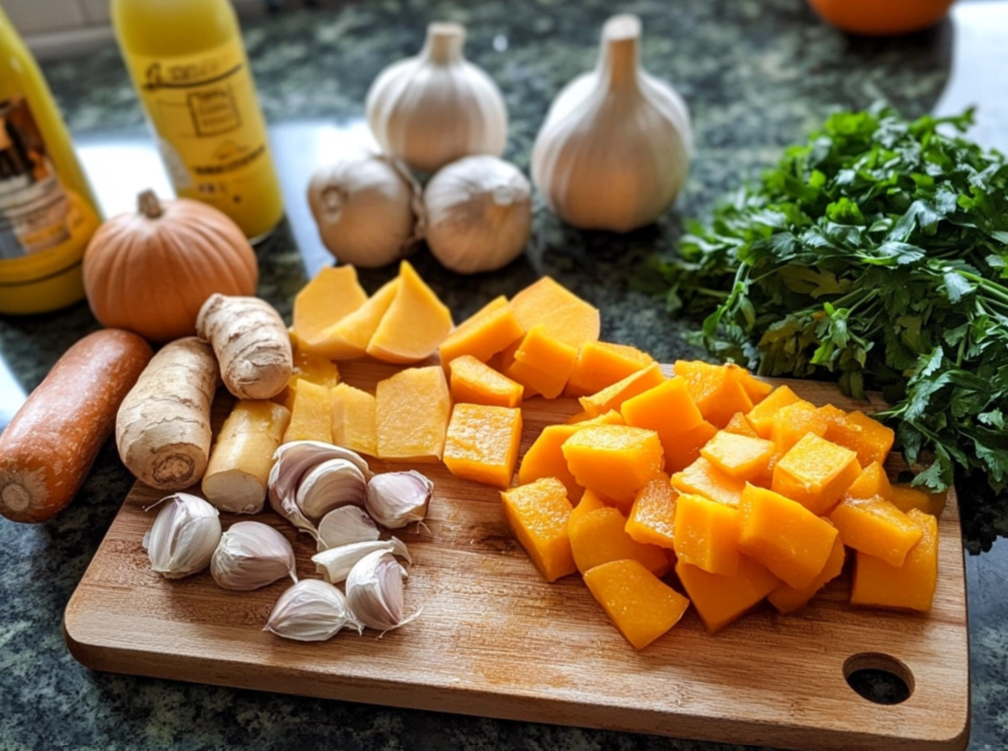Warm up with a creamy butternut squash soup packed with flavor and nutrients, perfect for any season.
Introduction to Butternut Squash Soup
Indulge in the rich and velvety texture of butternut squash soup, a comforting and nutritious meal ideal for any time of the year. This soup combines the natural sweetness of butternut squash with savory spices, creating a harmonious blend of flavors that soothe the soul and nourish the body.
What Is Butternut Squash Soup?
Butternut squash soup is a delightful blend of roasted or sautéed butternut squash, vegetables, and spices, pureed to achieve a smooth and creamy consistency. Butternut squash soup is beloved for its versatility and the ability to adapt to various dietary preferences. Moreover, it serves as a perfect starter for a meal or a hearty main course on its own.
Key Ingredients for Butternut Squash Soup
To craft a delicious butternut squash soup, you’ll need the following essential ingredients:
- Butternut Squash: The star ingredient, offering a sweet and nutty flavor.
- Vegetables: Onions, garlic, carrots, and celery add depth and richness.
- Broth: Vegetable or chicken broth serves as the base, enhancing the soup’s flavor.
- Spices: Nutmeg, cinnamon, thyme, and black pepper bring warmth and complexity.
- Dairy: Heavy cream or coconut milk adds creaminess, though dairy-free options are available.
- Olive Oil or Butter: For sautéing vegetables and enriching the soup.
- Optional Add-ins: Apples, ginger, or maple syrup for added sweetness and flavor.

Why Choose Butternut Squash Soup?
Butternut squash soup is not only delicious but also incredibly nutritious. It is rich in vitamins A and C, fiber, and antioxidants, which contribute to overall health and well-being. Additionally, butternut squash soup is easy to prepare, making it a convenient option for busy weeknights or elegant gatherings. Furthermore, its vibrant color and smooth texture make it an appealing dish that enhances any dining table.
Health Benefits of Butternut Squash Soup
Incorporating butternut squash soup into your diet offers numerous health benefits, making it a wholesome and energizing meal choice.
Nutritional Value
Butternut squash soup provides a balanced mix of essential nutrients. Butternut squash is a powerhouse of vitamins A and C, which support immune function and skin health. Additionally, it offers a good amount of fiber, promoting digestive health and sustained energy levels. Vegetables like carrots and onions contribute additional vitamins, minerals, and antioxidants, enhancing the soup’s nutritional profile. Moreover, using whole grains or beans as add-ins can increase the protein and fiber content, making the soup more filling and nutritious.
Immune Support
The high levels of vitamin C in butternut squash soup help boost the immune system, protecting the body against common illnesses. Additionally, antioxidants present in the squash and vegetables combat free radicals, reducing inflammation and supporting overall health. Consequently, regularly consuming butternut squash soup can contribute to a stronger immune system and better resistance to infections.
Heart Health
Butternut squash soup is beneficial for heart health due to its low cholesterol content and the presence of healthy fats from olive oil or butter. Butternut squash contains potassium, which helps regulate blood pressure and supports cardiovascular function. Furthermore, the fiber in the soup aids in lowering bad cholesterol levels, reducing the risk of heart disease. Consequently, enjoying butternut squash soup can be a heart-healthy addition to your diet.
Weight Management
For those aiming to manage their weight, butternut squash soup is an excellent choice. The combination of fiber and protein promotes satiety, helping you feel full longer and reducing the likelihood of overeating. Moreover, the low-calorie nature of the soup makes it a satisfying meal without excessive calories. Consequently, butternut squash soup supports weight loss and maintenance goals while providing essential nutrients.
How to Prepare Butternut Squash Soup
Creating a delectable butternut squash soup is straightforward and requires only a few simple steps. Follow this guide to craft a perfect bowl of comfort.
Step-by-Step Cooking Instructions
1. Roast the Butternut Squash
Preheat your oven to 400°F (200°C). Cut the butternut squash in half lengthwise and remove the seeds. Brush the flesh with olive oil, season with salt and pepper, and place it cut-side down on a baking sheet. Roast for about 45 minutes or until the squash is tender and caramelized. Roasting the squash enhances its natural sweetness and adds a depth of flavor to the soup.
2. Sauté the Vegetables
In a large pot, heat a tablespoon of olive oil or butter over medium heat. Add chopped onions, garlic, carrots, and celery. Sauté until the vegetables are soft and fragrant, approximately 10 minutes. This step builds the foundational flavors of the soup, making it rich and aromatic.
3. Add Spices and Aromatics
Stir in spices such as nutmeg, cinnamon, thyme, and black pepper. Cook for an additional minute to allow the spices to release their flavors. Adding spices at this stage infuses the soup with warmth and complexity, elevating its overall taste.
4. Combine Squash and Broth
Once the squash is roasted, scoop the flesh into the pot with the sautéed vegetables. Pour in vegetable or chicken broth, covering the ingredients. Bring the mixture to a simmer and let it cook for about 20 minutes, allowing the flavors to meld together. Combining the squash with broth creates a flavorful and hearty base for the soup.
5. Puree the Soup
Using an immersion blender, puree the soup directly in the pot until it reaches a smooth and creamy consistency. Alternatively, you can transfer the soup in batches to a blender and blend until smooth. Pureeing the soup ensures a velvety texture that is both comforting and satisfying.
6. Add Creaminess
Stir in heavy cream, coconut milk, or a dairy-free alternative to add richness and creaminess to the soup. Heat the soup gently until it is warmed through, but avoid boiling to prevent curdling. Adding creaminess enhances the mouthfeel and depth of the soup, making it luxurious and indulgent.
7. Adjust Seasonings and Serve
Taste the soup and adjust the seasonings as needed, adding more salt, pepper, or spices to suit your preference. Serve the butternut squash soup hot, garnished with fresh herbs, a drizzle of cream, or a sprinkle of roasted pumpkin seeds for added texture and flavor. Adjusting the seasonings ensures the soup is perfectly balanced and tailored to your taste.
Tips for Perfect Butternut Squash Soup
- Use Ripe Squash: Ensure your butternut squash is fully ripe for maximum sweetness and flavor. Gently press the squash; it should yield slightly but not be mushy.
- Roast for Enhanced Flavor: Roasting the squash caramelizes its natural sugars, adding a deeper flavor to the soup.
- Balance the Sweetness: Adjust the sweetness by adding a splash of apple cider or a teaspoon of maple syrup if desired.
- Incorporate Fresh Herbs: Fresh herbs like sage, rosemary, or parsley can add a burst of freshness and elevate the soup’s flavor profile.
- Serve with Crusty Bread: Pair your soup with a slice of crusty bread or a warm baguette for a complete and satisfying meal.
Variations and Enhancements for Butternut Squash Soup
Butternut squash soup is incredibly versatile and can be customized to cater to different tastes and dietary preferences. Here are some popular variations to inspire your culinary creativity.
Spicy Butternut Squash Soup
Add a kick to your soup by incorporating chili flakes, cayenne pepper, or a dash of hot sauce. Additionally, top with a swirl of sriracha or spicy croutons for an extra layer of heat. Consequently, spicy butternut squash soup offers a bold and invigorating flavor profile that excites the palate.
Butternut Squash and Apple Soup
Enhance the natural sweetness of the squash by adding apples. Peel and dice an apple and sauté it with the vegetables before adding the squash and broth. Additionally, a splash of apple cider can amplify the fruity notes. Consequently, butternut squash and apple soup provides a delightful balance of sweet and savory flavors.
Creamy Butternut Squash and Coconut Soup
Replace dairy with coconut milk for a creamy, dairy-free version. Incorporate ginger and lemongrass for an Asian-inspired twist. Additionally, top with toasted coconut flakes and fresh cilantro. Consequently, creamy butternut squash and coconut soup offers a rich and exotic flavor that caters to those seeking dairy-free options.
Butternut Squash and Kale Soup
Boost the nutritional value by adding kale or other leafy greens. Stir in chopped kale during the last 10 minutes of simmering to maintain its vibrant color and texture. Additionally, a squeeze of lemon juice can brighten the flavors. Consequently, butternut squash and kale soup is a hearty and nutrient-dense option that supports overall health.
Butternut Squash and Lentil Soup
Incorporate red lentils for added protein and fiber. Rinse and cook the lentils separately before adding them to the soup. Additionally, enhance the flavor with cumin and coriander. Consequently, butternut squash and lentil soup is a robust and filling meal perfect for vegetarians and those seeking plant-based protein.
Butternut Squash and Sage Soup
Add fresh sage leaves during the cooking process for an earthy and aromatic flavor. Additionally, sprinkle toasted sage leaves as a garnish to enhance the presentation. Consequently, butternut squash and sage soup offers a sophisticated and fragrant twist to the classic recipe.
Pairing Butternut Squash Soup with Other Dishes
Creating a balanced and satisfying meal involves pairing butternut squash soup with complementary dishes. Here are some excellent pairings to enhance your dining experience.
Appetizer Pairings
- Bruschetta: Fresh tomato and basil bruschetta adds a vibrant and tangy contrast.
- Stuffed Mushrooms: Savory stuffed mushrooms complement the soup’s richness.
- Caesar Salad: A crisp Caesar salad provides a refreshing balance to the creamy soup.
- Garlic Bread: Warm garlic bread offers a satisfying crunch and flavor pairing.
- Caprese Skewers: Fresh mozzarella, tomatoes, and basil skewers add a light and tasty starter.
Main Course Pairings
- Roasted Chicken: Tender roasted chicken pairs beautifully with the smoothness of the soup.
- Grilled Cheese Sandwich: A classic grilled cheese sandwich adds a comforting and indulgent element.
- Quinoa Pilaf: A nutritious quinoa pilaf complements the soup with added protein and texture.
- Herbed Pork Chops: Flavorful herbed pork chops provide a hearty and satisfying main dish.
- Vegetable Lasagna: A rich vegetable lasagna balances the soup’s creamy consistency.
Side Dish Pairings
- Roasted Vegetables: A medley of roasted vegetables enhances the meal with additional flavors and nutrients.
- Mashed Potatoes: Creamy mashed potatoes offer a comforting side that pairs well with the soup.
- Steamed Green Beans: Lightly steamed green beans add a fresh and crunchy contrast.
- Buttered Noodles: Simple buttered noodles provide a versatile and easy side option.
- Fruit Salad: A sweet and tangy fruit salad adds a refreshing touch to the meal.
Dessert Pairings
- Apple Crisp: A warm apple crisp offers a sweet and comforting finish.
- Pumpkin Pie: Pumpkin pie complements the autumnal flavors of butternut squash soup.
- Chocolate Mousse: A rich chocolate mousse provides a decadent ending to the meal.
- Berry Tart: A fresh berry tart adds a light and fruity contrast.
- Cinnamon Rolls: Soft cinnamon rolls offer a sweet and spiced complement to the savory soup.
Beverage Pairings
- White Wine: A crisp white wine like Sauvignon Blanc pairs well with the soup’s flavors.
- Apple Cider: Warm apple cider enhances the soup’s sweetness and richness.
- Sparkling Water: Sparkling water keeps the meal light and refreshing without overpowering flavors.
- Herbal Tea: A soothing herbal tea like chamomile or peppermint complements the meal beautifully.
- Spiced Hot Chocolate: A spiced hot chocolate adds a cozy and indulgent beverage option.

Complementary Dishes from Our Website
For a complete meal, consider adding No-Bake Cheesecake Cups for dessert or Bacon and Sausage for an extra savory component to your meal.
Sustainability and Butternut Squash Soup
In today’s environmentally conscious world, sustainability in food choices is increasingly important. Therefore, butternut squash soup can be made more sustainable with mindful ingredient choices and preparation methods. Consequently, adopting sustainable practices not only benefits your health but also the planet.
Choosing Sustainable Ingredients
- Organic Butternut Squash: Opt for organic butternut squash to support sustainable farming practices and reduce pesticide use.
- Local Vegetables: Purchase vegetables from local farmers to reduce carbon footprint and support the local economy.
- Seasonal Produce: Use seasonal vegetables to ensure freshness and minimize environmental impact.
- Eco-Friendly Packaging: Choose ingredients with minimal or recyclable packaging to lessen environmental impact.
Reducing Food Waste
- Portion Control: Serve appropriate portions to minimize leftovers and reduce waste.
- Creative Repurposing: Use leftover soup as a base for other dishes like stews or sauces.
- Proper Storage: Store any leftovers properly to extend their shelf life and maintain quality.
Eco-Friendly Cooking Practices
- Energy Efficiency: Use energy-efficient appliances and cooking methods to reduce energy consumption.
- Minimal Waste: Utilize all parts of the ingredients, such as using vegetable scraps in broths or smoothies.
- Composting: Compost any food scraps to reduce landfill waste and enrich your garden soil.
Storing and Preserving Butternut Squash Soup
Proper storage ensures that your butternut squash soup remains fresh and delicious for future meals. Therefore, follow these guidelines to maintain the quality and safety of your dish.
Refrigeration Tips
- Airtight Containers: Store the butternut squash soup in airtight containers to prevent it from drying out or absorbing odors from other foods. Utilizing airtight containers is essential in maintaining the integrity and flavor of your soup. These containers create a sealed environment that preserves moisture and prevents the transfer of unwanted aromas from other items in the refrigerator.
- Cool Before Storing: Allow the soup to cool to room temperature before refrigerating to maintain its texture. Allowing the soup to cool ensures that condensation does not form inside the storage container, which can lead to sogginess and degrade the overall quality of the dish.
- Consume Within 4 Days: For the best flavor and safety, enjoy the butternut squash soup within four days of preparation. Consuming within four days guarantees that the dish retains its optimal taste and nutritional value while minimizing the risk of bacterial growth and spoilage.
Freezing Methods
While butternut squash soup is best enjoyed fresh, it can be frozen for longer storage with some adjustments:
- Portioning: Divide the soup into individual portions before freezing. This allows for easy thawing and reheating based on your needs.
- Use Freezer-Safe Containers: Store the portions in airtight, freezer-safe containers or heavy-duty freezer bags to prevent freezer burn and preserve freshness.
- Labeling: Clearly label each container with the date and contents for easy identification. This helps in keeping track of storage time and ensures you use the oldest batches first.
- Use Within 3 Months: For optimal quality, consume the frozen soup within three months. Although it remains safe beyond this period, the texture and flavor may begin to deteriorate.
Thawing Techniques
- Refrigerator Thawing: Transfer the frozen butternut squash soup to the refrigerator overnight to thaw slowly. This method preserves the texture and flavor without compromising safety.
- Microwave Thawing: Use the microwave’s defrost setting, stirring occasionally to ensure even thawing. Microwave thawing is quicker but requires careful monitoring to prevent overheating.
- Avoid Refreezing: Once thawed, avoid refreezing to maintain quality and safety. Refreezing can cause the soup to become watery and lose its fresh taste.
Reheating Tips
When reheating butternut squash soup, do so gently to preserve its texture:
- Stovetop: Heat the soup over medium-low heat, stirring occasionally until warmed through.
- Oven: Pour the soup into an oven-safe dish, cover, and bake at 350°F (175°C) until heated.
- Microwave: Heat in the microwave in short intervals, stirring in between, until the soup is evenly warmed.
Food Safety Practices
- Avoid Cross-Contamination: Use separate utensils and cutting boards for raw and cooked ingredients to prevent the spread of bacteria.
- Proper Cooling: Cool any leftover soup quickly by spreading it out in shallow containers before refrigerating.
- Check for Spoilage: Discard any soup that shows signs of mold, off-smells, or unusual textures. Safe food practices are essential to prevent foodborne illnesses.
Frequently Asked Questions
Is butternut squash soup good for you?
Yes, butternut squash soup is highly nutritious. It is rich in vitamins A and C, fiber, and antioxidants, which support immune function, skin health, and digestion. Additionally, it provides essential minerals like potassium and magnesium, contributing to overall health. When prepared with wholesome ingredients, butternut squash soup is a healthy and satisfying meal option.
Why does my butternut squash soup taste bitter?
A bitter taste in butternut squash soup can result from overcooking the squash, using bitter vegetables like kale without balancing flavors, or not roasting the squash properly to enhance its natural sweetness. To prevent bitterness, ensure the squash is roasted until tender and sweet, balance flavors with sweet or acidic ingredients like apples or lemon juice, and avoid overcooking the vegetables.
Do I need to peel butternut squash for soup?
Yes, peeling butternut squash is recommended for soup to achieve a smooth and creamy texture. The skin of butternut squash is tough and can be unpleasant to eat. To peel, use a sturdy vegetable peeler or a sharp knife to remove the outer skin before chopping and cooking the squash for your soup.
What flavors go best with butternut squash?
Butternut squash pairs well with a variety of flavors, including:
- Spices: Nutmeg, cinnamon, thyme, and cumin add warmth and depth.
- Sweet Ingredients: Apples, maple syrup, and honey complement the squash’s natural sweetness.
- Acidic Elements: Lemon juice, apple cider vinegar, and balsamic vinegar balance the richness.
- Herbs: Sage, rosemary, and parsley enhance the soup’s freshness.
- Savory Additions: Bacon, sausage, and parmesan cheese add a savory contrast.
Incorporating these flavors can elevate your butternut squash soup and create a well-balanced and flavorful dish.
Conclusion
Butternut squash soup is a versatile and delectable dish that combines the natural sweetness of butternut squash with savory vegetables and aromatic spices, all blended into a smooth and creamy consistency. This recipe is not only easy to prepare but also offers numerous health benefits, making it a perfect choice for any meal of the day. Whether you’re seeking a comforting bowl of soup on a chilly evening, a nutritious lunch option, or an elegant starter for a dinner party, butternut squash soup is sure to satisfy your taste buds and nourish your body. By following our comprehensive guide and experimenting with various ingredients and techniques, you can master this delightful dish and make it a staple in your culinary repertoire. Therefore, embrace the rich flavors and enjoy the simplicity of butternut squash soup as a delicious and healthy addition to your meal planning.

